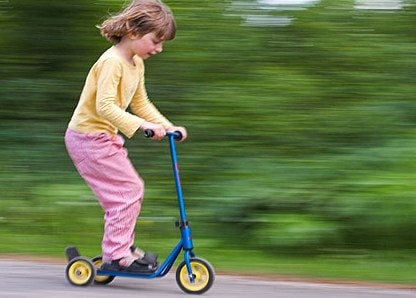The flowerstick and its benefits – skill development
In short, the flowerstick develops the following skills and abilities:
Gross motor and fine motor skills, Motor coordination, Eye-hand coordination, Reflexes, Sense of rhythm, Concentration, Relaxation, Multitasking, Sense of balance, Creativity, Rright and left brain coordination, Patience.
The beauty of it all is that the effects of the flowerstick on these are interrelated and add up, as follows:
Gross motor and fine motor skills

The ability to move the muscles in your body and therefore the different parts of your body is called motor skills. This applies to both the larger parts of the body (legs, arms, head, …) and the smaller parts (wrists, fingers, toes, …) too..
The more developed levels of motor skills are called fine motor skills. It is a different level of difficulty to put a ball in a box than to pull a thread through the hole of a needle. The latter requires much finer motor skills.
Imagine the difference between catching a ball or an egg thrown at you. You have to be much more careful and precise with the egg if you don’t want to break it. The movement of catching an egg is quite similar to playing with the flowerstick, as you have to keep catching the flowerstick with a similarly delicate movement as it is trying to fall to the ground. It doesn’t react well to sudden movements and strikes. That’s how juggling teaches you to use the finest movements of your smallest muscles.
Motor coordination

Whereas in the previous section on motor skills, we talked about the efficient movement of individual muscles and body parts, in this section we talk about motor coordination, i.e. the optimal coordination of the movement of muscles and body parts.
The flowerstick demands coordinated movement, just like dancing, gymnastics, or almost any other sport or game (building a house of cards, playing Frisbee, …). However, while building a house of cards or playing yo-yo mainly requires you to use just your hands and eyes, ice dancing or horse-riding requires much more than that. For more complex tasks, it’s essential to have proper control of many more parts of your body and senses working together. And the flowerstick helps you step by step to develop these skills, so you can gradually have a well-functioning body.
Eye-hand coordination

Eye-hand coordination is also directly linked to movement coordination and motor skills, as the use (movement) of all parts of the body can be properly coordinated by controlling the eyes.
To catch a ball (or an egg) thrown towards you, you need not only the movement of your hands but also the cooperation of your eyes to coordinate the movement properly. You experience and develop the same thing when you’re playing with the flowersick, when your eyes and hands are always working together to succeed.
Reflexes

Reflex is the body’s response to a stimulus from the environment. It can only be accelerated and improved with practice…
Every minute of the flowerstick game develops your reflexes, as you need constant (fast) reactions; especially if you want to play quickly and accurately. You need fast movements and good reflexes to follow the movements of the flowerstick (its spin) correctly. The formula is simple: if you react too late, the stick will fall.
Good to know: if you have good reflexes from the beginning, you will have a big advantage in any (juggling) game. However, it is also okay if you are not very advanced in this area, because you will benefit more from the flowerstick. At the beginner level, you don’t necessarily need fast reflexes, but rather slower movements. As you progress, you will be able (and want) to do more and more beautiful and faster tricks, and with practice, your reflexes will gradually improve and you will get better at it 🙂
Rhythm

Rhythm is the repetition of the same or a pattern of sounds or movements. And the sense of rhythm is the degree to which you can consciously feel and follow it.
There can be no truly beautiful flowerstick play without the right tempo. If the rhythm is not there, the stick will fall down. That’s why if you’ve played music before, you’ll learn the game of flowerstick much faster. If you have never played music before, you will have to practice more, but you will also develop your musical sense. And you can even combine the flowerstick game with music! If you’ve never tried it before, put on some of your favourite music and start playing (if you’re a beginner, start with a slower beat) ☺! Music makes playing with the flowersticks particularly enjoyable, and if you’re good at it, the world around you will disappear, leaving just you, the stick, and the music… It feels reeeally awesome!!! 🙂 This is the time when you can most easily understand what the flowerstick has to do with meditation and relaxation (more on this below, under concentration and relaxation).
Concentration

Focusing attention and directing thoughts toward a task, topic, or object is called concentration. Whatever you want to get better at, you need to be able to block out the external factors when you do it. You will be a good shooter and also a good racecar driver if you concentrate only on the task at hand at the right moment. That’s where the flowerstick can help you.
When you’re playing with the flowerstick, the stick becomes the focus of your attention. You have to follow the game not only with your movements and your eyes, but also with your thoughts, which helps you concentrate and focus. With practice, you get your brain used to focusing on one thing – in this case, on the flowerstick. The concentration – which you train while playing with the flowersticks- will help you later on when you need to focus on other tasks.
Good to know: for many children, lack of concentration causes serious problems. Playing with the flowerstick helps them learn how to focus their attention and relax their brain.
Relaxation
 Even the earliest – assumed – flowerstick users, the soldiers of the ancient Chinese empire, practiced to become more relaxed and focused (and, of course, faster and more skilful too). Relaxation is an activity that requires concentration and helps to calm the mind, bringing harmony to the body and soul.
Even the earliest – assumed – flowerstick users, the soldiers of the ancient Chinese empire, practiced to become more relaxed and focused (and, of course, faster and more skilful too). Relaxation is an activity that requires concentration and helps to calm the mind, bringing harmony to the body and soul.
And that’s exactly what you’re doing when you’re playing with the flowerstick. You turn off your mind and just play with the sticks. If you’re a beginner, your attention is even more focused on dropping the stick as few times as possible and getting the first one or two tricks right. If you’re more experienced, the focus will be on improvisation. In both cases, playing with the flowersticks will make you feel completely “switched off,” but you’ll really feel this when you become a more skillful player.
Good to know: for more of an impact, it’s also worth combining your playing with listening to music (see sense of rhythm) to really feel the Flow ☺
Multitasking

Multitasking is a higher level of concentration when you can focus on more than one thing at the same time.
If you’re a beginner stick player, the focus is on improving your concentration as you try to practice a couple of tricks at a time, so that you avoid dropping the flowerstick as much as possible. Although most of the time you’ll be using both hands and need to divide your attention between them but this time it has less importance. But when you’re playing better, and practising how to combine different tricks in a spectacular way, or even incorporating as many of your body parts as possible into the game, it requires a lot more multitasking. It’s a skill that can be developed to help you concentrate on more than one thing at a time.
As you become a really good flowerstick player, you will learn to divide your attention between the flowerstick kit and different parts of your body (one handstick, another handstick, flowerstick, arms, legs, fingers, etc.). In doing so, you’ll even be able to make breakfast while you’re playing with the flowerstick. And the top of multitasking – among flowerstick players – is when you can play with 2 flowersticks at the same time (right hand-left hand).
Sense of balance
 The sense of balance is the ability to keep the body stable. Its development improves reaction and the ability of coordination, strengthens muscles, and increases the efficiency of movements. Even the simplest movements and sports (e.g. running) can help, but the more complex the “task” (e.g. tightrope walking), the greater the challenge and the benefits.
The sense of balance is the ability to keep the body stable. Its development improves reaction and the ability of coordination, strengthens muscles, and increases the efficiency of movements. Even the simplest movements and sports (e.g. running) can help, but the more complex the “task” (e.g. tightrope walking), the greater the challenge and the benefits.
The flowerstick game is the perfect way to develop a sense of balance step by step. If you’re a beginner, it can be a challenge to keep your balance while playing. And while playing, you need to find the balance not only for yourself but also for your flowerstick.
Keeping your own balance is easy to explain: don’t fall over while playing! How to balance the flowerstick properly can be understood through the following example:
You balance with the handstick a motionless flowerstick lying horizontally differently than a spinning one in motion. In the first case, you have to find the centre of the flowerstick, in the second case, you have to get close to one of the edges. In addition to the position, you also have to take into account the speed of the spinning: the slower you want it to spin, the closer you should play to the centre of the stick, and the faster you want it to spin, the closer you should play to one of the ends of the stick.
Good to know: the more skilfully you play the flowerstick game, the faster you’ll learn to rope dance, monocycle, and anything else that requires a sense of balance.
Creativity

This simple game has countless possibilities and variations of tricks. The more you practise, the more new combinations you’ll come up with. In other words, it encourages creativity. Any kind of riddle, puzzle, or game that requires patience helps you think innovatively, but few can be said to develop you physically and mentally while practicing. Playing with the flowerstick helps you understand that there are many ways to solve a problem.
Good to know: Playing with others, in the open air, with music (see sense of rhythm) has the greatest impact on creativity. It is very stimulating to play with more than one person, so it has a kind of “brainstorming” (flow of ideas) effect, where one idea follows another. So, playing with your friends is more conducive to developing your creativity.
Right and left brain coordination

Moving different limbs stimulates the brain in different ways, so playing (in this case, the flowerstick game) also helps to develop different brain functions. When you use both hands at the same time, you are creating a bridge between the more analytical, more planning, logical thinking, and safety-oriented left brain and the more visual, imaginative, intuitive, and risk-taking right brain hemispheres. Since you need to use both your right and left hands together while playing with the flowerstick, practising to play the game also helps your brain work efficiently.
Patience

There is another great skill you can learn while playing with the flowerstick, and that is patience. Especially with yourself, because without time invested in practice, the game will not work. You have to bear in mind that the flowerstick game is a skill-building game, which on the one hand develops your skills, but on the other hand requires time and practice, which requires patience. You should always start from the basics and you can only progress step by step.
Of course, most things in life require patience, not just the flowerstick game. If you don’t put in enough effort, your kit can easily end up in the corner. However, many people (children) who are impatient by nature fall in love with this game, and for them, the flowerstick opens the “gate of patience”. They like it so much that it’s worth it for them to go all the way and wait for the success they dream about. It’s a skill they will eventually use for the rest of their lives.
Summary

The flowerstick game is a great, fun activity, it’s also great exercise and helps you learn new things more easily. It shows that the impossible doesn’t exist, you just need to practice more, which can be fun in itself! That’s what our slogan suggests:


 English
English
